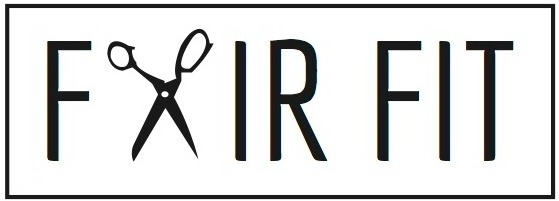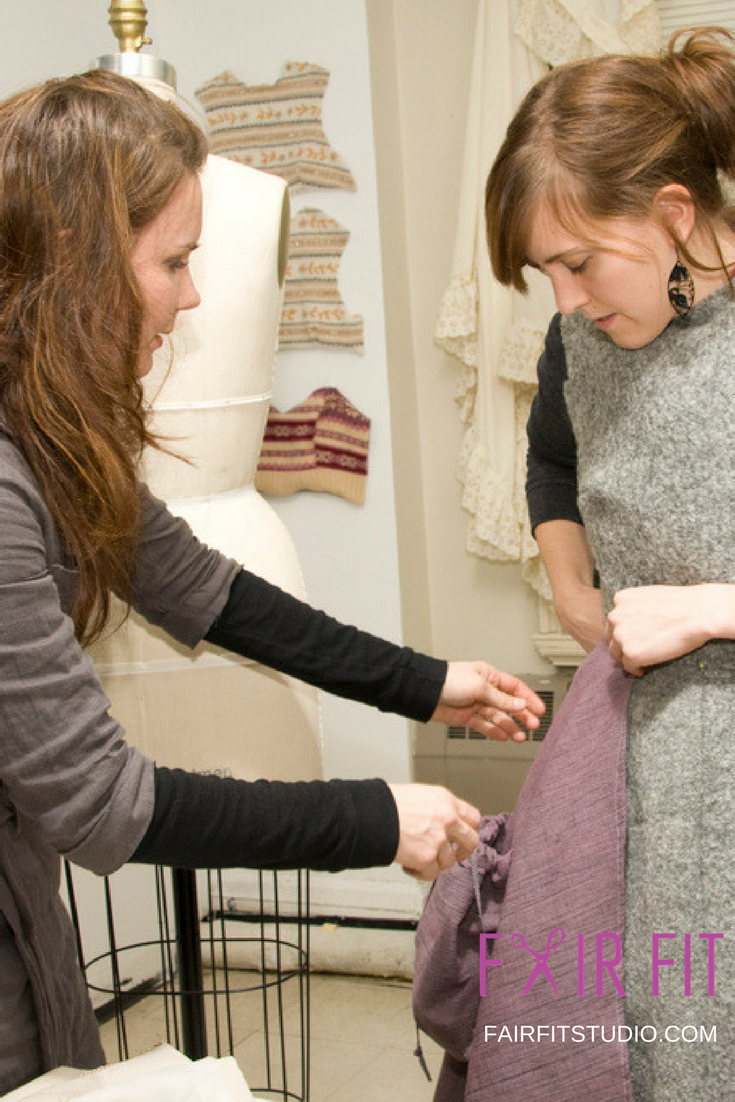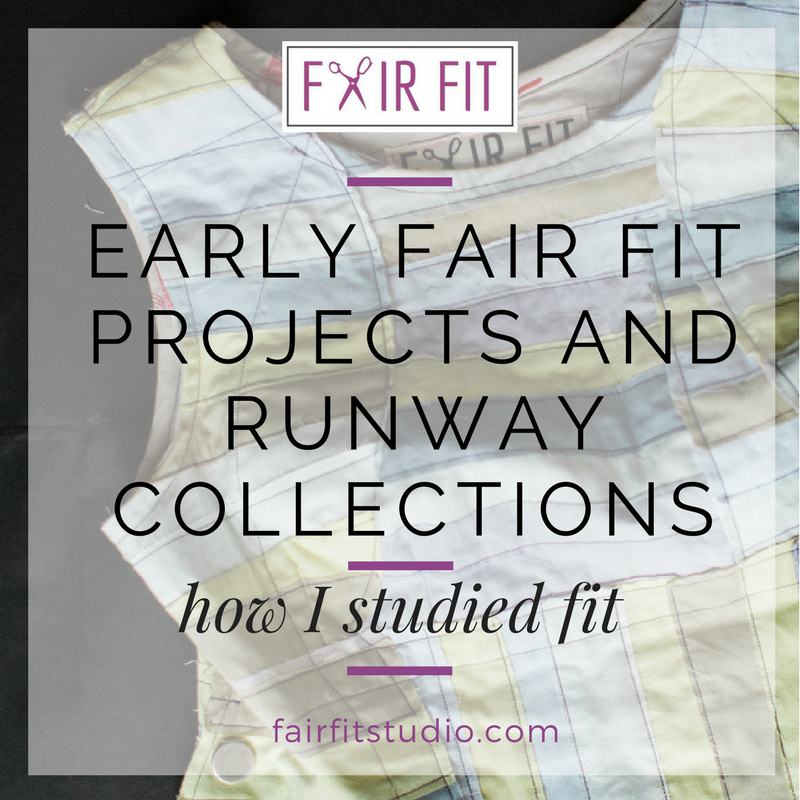What does "Fair Fit" Really Mean?
Lately, I have been asked the question quite a few times, why did I name my clothing and educational platform, Fair Fit? While I love answering this question, I'm surprised that I haven't discussed it here on our blog. Probably because to answer this question is going to take more than one blog post! But now's a good time to answer this question, starting with today's article. The name I have chosen has a great deal of meaning to me built into two small words.
To begin- I'll confess. Last year, I got really scared that I had the wrong name. That after the long and expensive process of legally protecting my business and teaching platforms through trademarking my logo and name Fair Fit, I was hit with the fearful thought that after all this work I could have the wrong name.
I sat with it. Is this name confusing? Does this name make people think I offer services I don't want to offer? Is it creating the perception that my focus is strictly on fitting problematic sewing patterns? These questions tumbled through my head, and thankfully, I arrived at the understanding.
Yes I have the right name, and no I'm not changing it.
But this experience did show me that I am definitely missing something. There is a story and very purposeful, meaningful reason as to why I use this name for my creative work and educational platform. And I have not been sharing it with my students and blog audience because I have been in the process of growing and creating educational sewing offerings.
I focus on my students and how I can help them learn. In the process of focusing my energy creating classes, articles, and other methods of learning, I have neglected the personal experience that informs my teaching perspectives.
And there's some good stories and life lessons to share in my personal experience and history as a maker. And if you are going to trust someone else to your learning, I think its important to know your teacher's work and how their perspective is shaped by their professional experience. Then you can decide if those perspectives resonate with you, and what you are most wanting to experience in YOUR learning, and decide if you and I are a "fair fit" :)
This series will start exploring and documenting the history that informs how I teach and what I share here on this blog that explains my experience with fashion and what the name I chose, "Fair Fit", actually means. The story DOES have a lot to do with fit. And it has lots of dramatic twists and turns from which to learn so stay tuned as this series unfolds.
Where does Fair Fit come from?
During interviews, I am often asked why we are named Fair Fit, and I explain that I have a lot of beliefs from working in my small fashion businesses I've had over the years that created my own perspective of fair fashion.
I will save all of the examples from my body of work and experience for the next few articles, but what I always come back to is that fair fashion is encompasses more than only thinking about how your clothes are made and where they come from. I believe fair fashion should really encompass a series of "Fair Relationships." Ha- if I did change our name, it would be to Fair Relationships :)
In fashion, you must learn to work with other people. Even if you are an emerging designer and you are a one man or woman show, you will have to find a client who wears your designs in the world. How you negotiate fairly working with people creates a good and fair exchange, a Fair Fit you could say.
6 years ago, I started my Fair Fit clothing project based on the ways my fashion designs and patterns worked for other people. It was named Fair Fit because the approach to a garment's design incorporated the choice of the wearer as to how the final garment fits, based on THEIR perceptions of what is comfortable, easy to wear, and looks and feels the way they think best fits their individual body. It was a pattern puzzle designed to create a collaboration between me and the client. And you, the client, having the freedom of choice in the garment you wear instead of me, the designer, making all of the decisions for you- that sounds pretty fair right?
I left openings in the engagement with the pattern for another person to put their own spin, and express their own ideas. Working this way provided a collaboration where two people bring their unique expressions to the table.
Image from my Chicago studio. 2009
This fairness of exchange in relationship, carried over from this project into my life. As a fashion designer, it can be perceived as a mysterious profession and that can lead to it being falsely elevated over other types of work. It's inaccessibility to learn and participate in fashion doesn't help this matter. But that is not who I am as a person. I did not want to play a part in protecting it's exclusivity. I don't think its fair to:
1. Be the ultimate authority in a collaboration.
Collaboration is a two way street, and when a designer is elevated as the all knowing authoritative genius over a client, it's a big problem. Because fashion can seem difficult to find ways to participate because its dealing with our bodies, creating an outer skin, and there is so much written about what you "should" and "should not" wear.
It's easy to put a designer's decisions above your own because clothing can be confusing and become frustrating. But I believe that another person, no matter how talented they are, should not be your authority as to what you wear and how you feel good. That is up to all individuals to decide.
2. I don't think the skills and path should be hidden in order to protect this exclusivity.
Fashion schools are EX-PEN-SIVE, and even the ones who make it to these schools face the limitations of trend and competition. Even if you become a business owner in this field, you will face the choice to be fair in your relationships, or to take unfair advantage in marketing, production, and how your client experiences your product.
Often the unfair advantage is taken in order to maintain the perception that not everyone gets to enjoy fashion and great clothing. That's not true. You do get to decide what field you want to play in. And you are responsible for that choice to bring it into your life and that's empowering.
When it comes to fairness in fashion, I believe a way to achieve and have what you desire is to take the freedom of choice that you do have and use it wisely. Everything is a choice, and that choice reflects a belief within you.
As an example, some of my earliest past choices look like this:
1. As a farm girl in Iowa, I first participated in fashion by making my own clothes. The clothes that inspired me in magazines or in my head just weren't available to me back then. So I taught myself how to sew and use a sewing pattern so I could make clothes that fit my vision.
2. When I wanted lots of ready to wear clothes, and I recognized how trendy my tastes were and how many different kinds of outfits I wanted to experience, that went beyond what a family could reasonably budget. With my teenage friends, I discovered thrifting, and I LOVED it because with my sewing skills and the excessive availability, I could play with so many more clothes than I could sew or purchase new. I remember my father's pride in how I found a way to play within my own personal capacity to manifest, and how much fun I and my friends had back then at the thrift store dressing up in different personas.
3. Later as a young adult I continued to thrift, sew, and create a crafted wardrobe all my own. I never worried about clothing, it was my pleasure and fun to make what I wanted. I felt so free, and not burdened by perceptions of what it all meant, or societal expectations and presumed suitability of dress.
My interests in fashion made their way into the visual arts practice I was studying, and after I finished my requirements in painting, I started to make visually compelling dresses that were hand sewn, one of a kind, art to wear pieces. They were performative personas, and as part of the work, I invited all my female friends to wear these pieces. I was able to share this passion with other people, and always it was a learning experience. And it was my first experience of other people having a strong desire to wear what I have made.
4. These dresses were very dramatic, statement pieces, they were art to wear. Soon, I was invited to participate in live shows locally, but also in New York City. My first real stage show was in Cooper Union Square, at the age of 22- I'll show you photos from that show in next week's post.
And the experience of sharing the dresses with my friends, and new people that I met in the city who became new friends, consistently offered this experience of freedom and fun through other people wearing clothing I made. Back then, I was a student and soon a recent graduate. I had no concern for business, or monetary exchange, rather I was concerned with growing an artistic body of work and my name as an artist, so I hadn't thought of that yet at my young age. I was still supported by my many part time jobs and was in the process of developing my voice and skill at my work.
My first collection, 2002. Photo by Sandra Dyas
5. My shows became more frequent, and during several of them I would be approached by audience members wanting to purchase the clothing in the show. There was no way I could sell those dresses because the were part of the show and would be worn again, and I could not compute the labor hours for the hand stitching and extensive construction of the dress. But when it came to entering the business of fashion, that's when the Fair Fit story began. I needed to learn how to create fair relationships of exchange, and collaboration, in order to move forward on my craft.
And I did learn, and am still learning about those exchanges. Look for next week's article, I'll tell you the story of my first clothing line and how fairness first entered the picture and how that influenced my business and experience as a young emerging designer.
In the next few articles, I am going to show you my projects and how they explored the idea of a fairness in fit. But beyond expertise, there's also philosophy at the core of my creative practice, how I teach, and create the work I put into this world. That philosophy breaks down like this:
1. Why teaching is so important.
Teach a man to fish is an important concept to me, and why it is fair to share the skills of sewing, design, and garment construction so others can use them to express themselves creatively.
2. The removal of “specialness” and exclusivity in fashion.
How that can happen through our relationships by creating definitions and boundaries on what's offered, what kinds of problems are solved, and by creating opportunity for others by empowering them with the same information I have in our exchange.
3. How “fair fashion” is really your own fashion
You will compromise your personal choices and freedoms if you want someone else to do it all for you. That transfers all of the power of your image and how you face the world to another person, brand, tailor, or designer, magazine editor, et all. Nothing will ever feel as authentic as when you decide when, how, and why to express your own perspective and skill through crafting clothing when you know you have a specific opinion and view you want to see in the world.
4. Fair relationships and how they better your experience with fashion
Fair relationships are built when both parties take complete responsibility for their own choices and the work that stems from those choices is fairly decided and distributed to the responsible party. If you want something to fit and look a certain way, that's being a designer and it means you have your own perspective you want to see in this world. You are likely to have a happier and more empowered relationship with your own clothing if you get the information and assign that responsibility to yourself, rather than delegating your vision.
Those 4 concepts will be conveyed throughout the posts in this series. I hope you will read along, and that by sharing these stories it helps inform your own personal story, and how you proceed on your own path with fashion.
See you next week!










